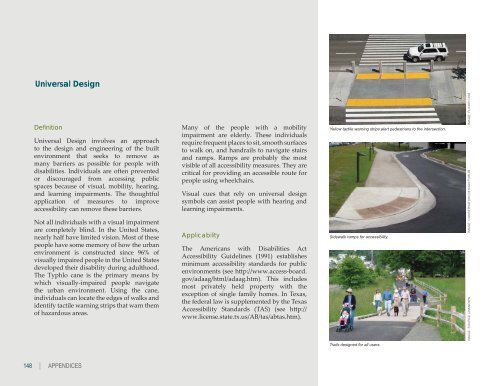design elements - San Jacinto Texas Historic District
design elements - San Jacinto Texas Historic District
design elements - San Jacinto Texas Historic District
Create successful ePaper yourself
Turn your PDF publications into a flip-book with our unique Google optimized e-Paper software.
Universal Design<br />
Defi nition<br />
Universal Design involves an approach<br />
to the <strong>design</strong> and engineering of the built<br />
environment that seeks to remove as<br />
many barriers as possible for people with<br />
disabilities. Individuals are often prevented<br />
or discouraged from accessing public<br />
spaces because of visual, mobility, hearing,<br />
and learning impairments. The thoughtful<br />
application of measures to improve<br />
accessibility can remove these barriers.<br />
Not all individuals with a visual impairment<br />
are completely blind. In the United States,<br />
nearly half have limited vision. Most of these<br />
people have some memory of how the urban<br />
environment is constructed since 96% of<br />
visually impaired people in the United States<br />
developed their disability during adulthood.<br />
The Typhlo cane is the primary means by<br />
which visually-impaired people navigate<br />
the urban environment. Using the cane,<br />
individuals can locate the edges of walks and<br />
identify tactile warning strips that warn them<br />
of hazardous areas.<br />
148 │ APPENDICES<br />
Many of the people with a mobility<br />
impairment are elderly. These individuals<br />
require frequent places to sit, smooth surfaces<br />
to walk on, and handrails to navigate stairs<br />
and ramps. Ramps are probably the most<br />
visible of all accessibility measures. They are<br />
critical for providing an accessible route for<br />
people using wheelchairs.<br />
Visual cues that rely on universal <strong>design</strong><br />
symbols can assist people with hearing and<br />
learning impairments.<br />
Applicability<br />
The Americans with Disabilities Act<br />
Accessibility Guidelines (1991) establishes<br />
minimum accessibility standards for public<br />
environments (see htt p://www.access-board.<br />
gov/adaag/html/adaag.htm). This includes<br />
most privately held property with the<br />
exception of single family homes. In <strong>Texas</strong>,<br />
the federal law is supplemented by the <strong>Texas</strong><br />
Accessibility Standards (TAS) (see htt p://<br />
www.license.state.tx.us/AB/tas/abtas.htm).<br />
Yellow tactile warning strips alert pedestrians to the intersection.<br />
Sidewalk ramps for accessibility.<br />
Trails <strong>design</strong>ed for all users.<br />
IMAGE: FLICKR.COM<br />
IMAGE: SOURCE UNKNOWN IMAGE: CONSERVATION DESIGN FORUM


